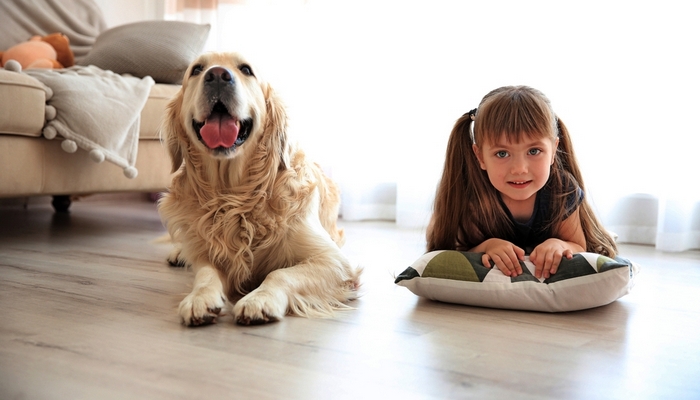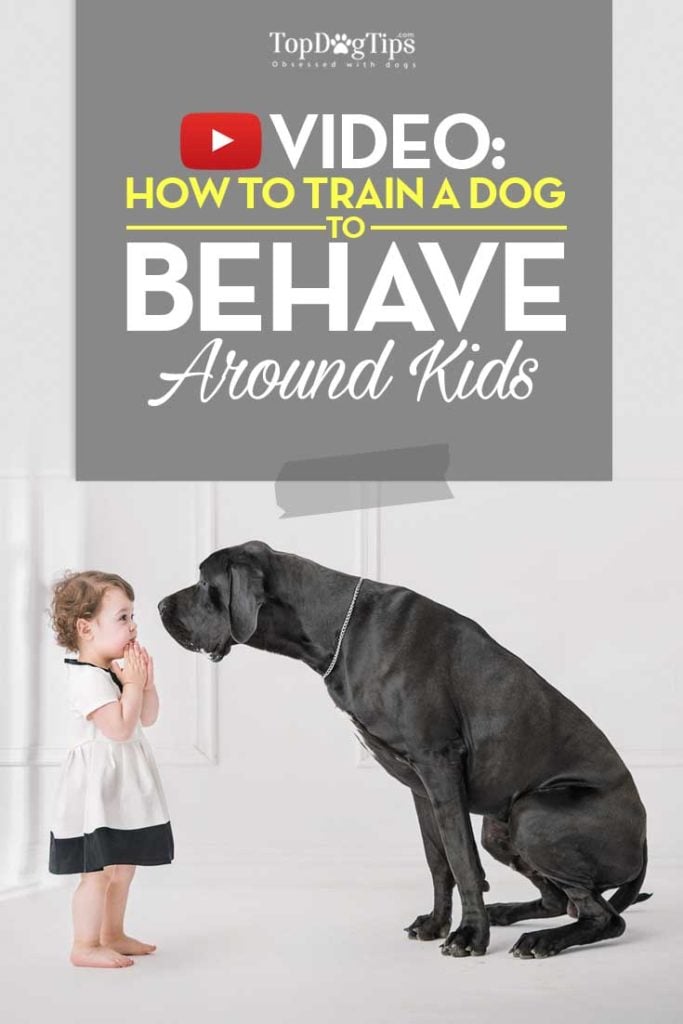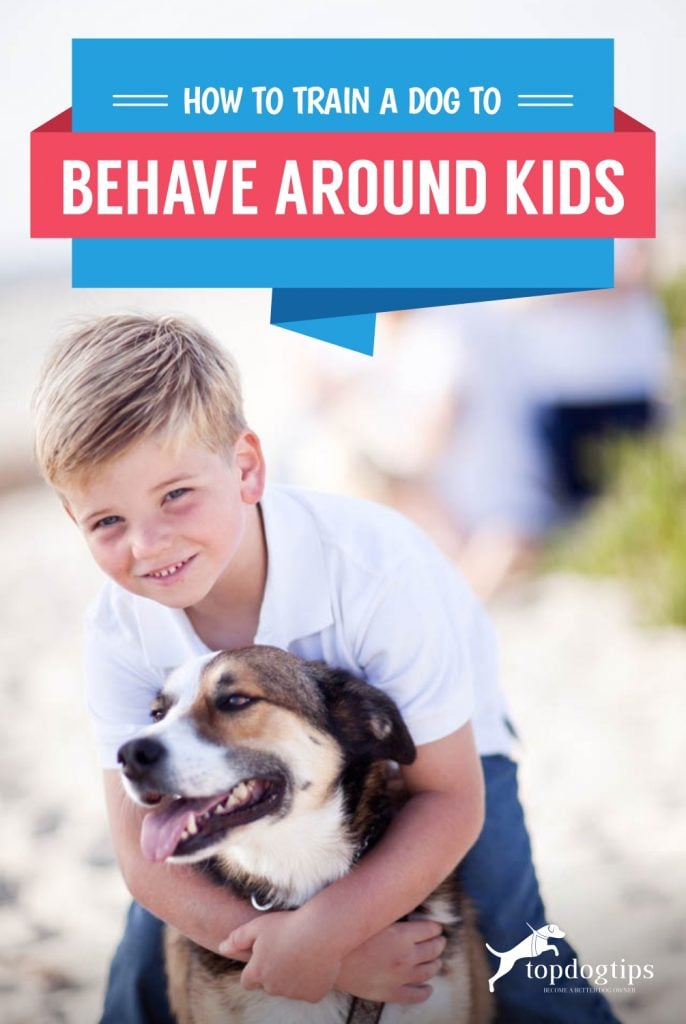For everybody's safety, it's important to teach your children to respect animals, but you also need to learn how to train a dog to behave around kids. It's a two-way street: just because your child learns to respect the dog doesn't mean the dog is automatically going to know how to behave around the youngest members of your family.
Table of Contents
Dogs and Kids…
Young kids and dogs are highly unpredictable. You never know what they'll do next, which can make for a dangerous combination. They should not be allowed to be unsupervised until you are completely sure that they both understand how to behave around each other.
If they're of age to understand, then you must first explain to children that they need to respect dogs, give them space and not be too rough with them. Likewise, dogs need to be trained and taught that they have to behave around small kids. They need to act calm and learn to deal with the unpredictable things that children do.
Sadly, there are some dogs that do not enjoy being around children. If your dog shows any signs of aggression around children, you'll need to work with a professional dog trainer that specializes in working with kids and dogs. A dog not being friendly with a kid is extremely serious, and it's not safe for you to try to handle it on your own.
Before you begin learning how to train a dog to behave around kids, he should already be trained with basic commands. Your dog should know how to properly walk on a leash, how to come when he is called and how to sit. It's also imperative that he has learned not to jump before you introduce him to children.
How to Train a Dog to Behave Around Kids
While some breeds are much better with kids, others won't be as tolerant. Think about the common traits of children. Sure, they're cute, funny, and they can be sweet, but they're also loud and make lots of fast movements. You need to help your dog get accustomed to the positive and negative aspects of being around little kids.
If you have children of your own, this will be easier. Your dog will be exposed to kids all day long, meaning he'll quickly get used to the noise and busyness that they bring and how they behave. However, if you don't have children of your own and want to train a dog to tolerate them just in case, this may be a bit more difficult.
Expose Your Dog to Children
If there are no kids in your home, take your dog (on a leash) somewhere that children are present. It's best to do this after you adopt the dog and make it part of socialization schedule. Public parks, beaches, and other areas that children may be playing are all great places to bring your pet for a walk.
Be sure to keep your dog on a leash at all times until you are completely sure that he knows how to behave around children and that the kids know the dog already. Let's say you bring him to the park to gain exposure to little humans: walk him around the perimeter of the park at first so that he does not have access to the children.
This will give your pet the opportunity to get used to the noise and movement without becoming overwhelmed by a swarm of kids that want to pet him.
As I explain in my video above, it's best to use a harness and leash combo, and have a sign on the dog's harness that says “Do Not Pet” when you're first taking the Fido to a public place where children are present.
This is most important if you adopt an older dog, as puppies typically aren't aggressive toward children when exposed to them at a very young age. If you don't want to use a well marked harness and leash, always be aware of anyone coming toward your dog and ask them to keep a safe distance.
Let the Dog Play with Familiar Children
Once you're sure that your dog has had plenty of exposure to kids and he is not going to act aggressively, it's time to let him play with some children. If you don't have kids of your own, invite family members or friends with children to come over and play.
Be sure that your dog's first encounters with kids are all positive.
When teaching a dog to behave around children, safety is the top priority. Adopt the right breed and keep the dog on a leash during the first few encounters until you're 100% sure that the dog won't react aggressively to the kid. Again, this is most important with adult dogs and senior dogs, as puppies typically enjoy being around young ones.
Your dog should already know basic commands for safety reasons. If you have kids of your own, this is obviously impossible with a newly adopted pet, but you should work on command training as soon as you bring the dog home.
During the introduction, give the kids a few dog treats before they walk into the house. While on the leash, allow your dog to walk over and greet the kids. If he greets them calmly without jumping, they can give him a treat. If he is too excited, make your dog wait until he calms down before allowing him to greet the kids. If your dog responds timidly to children, enlist the help of some calm, older children to help you.
Recommended Supplies for Dogs vs Kids Introductions
If you're getting ready to introduce a dog to a kid, or a kid to a dog, some tools can be extremely helpful to ensure safety of both parties. I've rescued many dogs over 20 years and introduced them to my children, and I've always used leashes, harnesses, gates, and similar items to help make this process smoother and easier.
| Preview | Product | Rating | |
|---|---|---|---|

|
DO NOT PET Dog Vest Harness with Removable Patches... | 1,699 Reviews | Check Price |

|
PREMIUM CARE Hemp Calming Chews for Dogs Anxiety,... | 49,265 Reviews | Check Price |

|
Carlson Extra Wide Walk Through Pet Gate with... | 31,020 Reviews | Check Price |

|
PetSafe SprayShield Animal Deterrent with Clip -... | 3,789 Reviews | Check Price |

|
The Dog Encyclopedia for Kids | 797 Reviews | Check Price |
Take Home Message
If your dog acts aggressively in any way and at any point when introduced to children, you need to seek the help of a professional dog trainer immediately. Oftentimes, older dogs or dogs that have had negative experiences with children in the past will show signs of aggression when confronted by a child, or try to establish their dominance.
The signs that you should be looking for include:
- the dog becoming very still or rigid
- curling lips to show teeth
- growling
- poking the child with their muzzle
- barking
- lunging toward the child
- snapping or nipping
Learning how to train a dog to behave with kids isn't the only thing you should be worried about. Children also need to know how to properly act around dogs. I've made a guide on this topic as well. It explains what children need to know about dogs and how to teach them safe ways to interact and have fun with canine companions.
READ NEXT: 14 Safety Tips for Adopting a Dog When You Have Kids
Disclosure: We may earn affiliate commissions at no cost to you from the links on this page. This did not affect our assessment of products. Read more here and find full disclosure here.















